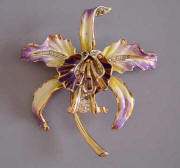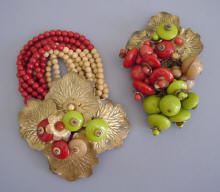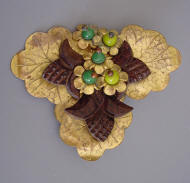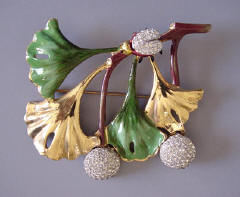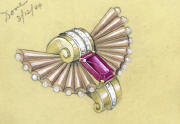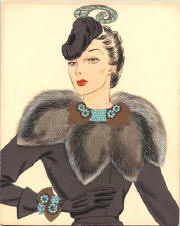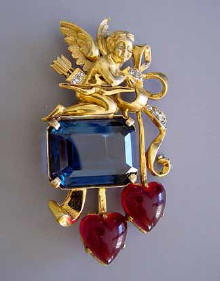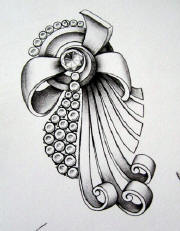|
|
|
Jewelry
Design Art & Advertising
|
Like any other artist, each jewelry designer is inspired
in a different way. For some it might be a color of Czech beads or a line of rose montees, for others, a flower from nature. Often a line was requested by the
marketing department who took into account the styles and colors of each
season, the beads, rhinestones and findings available, and the cost of
manipulating these into a 3-4 lines each year.
How the
designer takes his inspiration from idea to materials to finished product is a
journey rarely thought of when we enjoy the jewelry we wear.
|
|
DeROSA arrowroot
floral clip.
View
#d21160 |
De Rosa Arrowroot design
art work for the clip shown at left. #146 |
ROSENSTEIN
Oriental lady brooch with glass "coral" roses and cabochons and clear rhinestone headdress.
View #X23986 |
Rosenstein design pencil sketch for the bejeweled headdress brooch
shown at right. |
|
Costume
Jewelry Art
… how jewelry
was designed
|
We are lucky to have jewelry design art work to reference the process of
designing jewelry. Most of these design paintings are gouache and/or ink on
parchment. They demonstrate the development from an idea to the finished
product and lend insight into the creative process. Because some jewelry
designers manipulate their materials to form an original piece of jewelry from which other pieces could be
duplicated, art work for some pieces never existed. But others first develop
their ideas on paper, thereby using material that was meant to be temporary,
so it is amazing that any of these ephemeral pieces have survived.
In
many of these illustrations, an under-drawing in graphite can been seen, which was then colored
with gouache. Some illustrations also have notes
indicating changes to the designs or dates of manufacture. The amazing
detail and color belies the short life span these illustrations were meant
to have.
The art work and designs on
paper shown here are from the DeRosa, Haskell, Rosenstein and Barclay
companies. While some of these pieces actually went into production, some did
not, and some had changes made to the original design as the marketing
departments and sample makers made the desired adjustments.
|
|
DeROSA
bouquet of violets fur clip, 2-1/2 inches.
View
View View
#d18705
|
De Rosa original design art work for the clip shown at right
here. The note at the bottom
reads "violets", and the clip was indeed done in violets instead of
the forget-me-nots originally illustrated. #140 |
DeROSA sterling
cream and green enameled floral fur clip, 2-1/2".
View #d23488
|
De Rosa #103 cream
enameled lily bouquet clip.
|
|
BARCLAY
enameled leaves, ladybug and paved pods brooch.
View
View #X23718 |
BARCLAY original art work for a brooch design. |
DEROSA retro
purple rhinestone and artificial pearl brooch, 2" by 2-3/4".
View #d23931 |
DeRosa design art work.
Marked in pencil "Done 3-13-44" #230 |
|
Costume Jewelry
…inspired by
the real thing
|
Fine
jewelry was another the direct inspiration for vintage costume jewelry.
Trifari and Coro are good examples of costume
jewelry makers who recreated fine jewelry designs in the less expensive
materials of costume jewery. Lucite jelly bellies were copied from brooches that may have been created in
originally rock crystal set in karat gold. The
Trifari jelly belly bird brooch for example, shown at the right below,
could be one of these.
The same is true of Cartier’s "tuttie fruity" which, like the Trifari clip shown below,
used richly colored and shaped red, green and blue fruit-shaped elements as a
part of the design.
Tiffany did a series of enamel and diamond orchid brooches in the 1890s, and Coro mimicked them in the enamel and rhinestone orchid pins done in the
1940s, like the one shown below left.
Much of this jewelry was designed from the early 1930s to the late 1950s for
a celebrity clientele from Hollywood to royalty. The jewelry was often
featured in glamorous photos in Vogue, Harper’s Bazaar other magazines of
the era. Any research of jewelry will show motifs repeated in both fine and
costume jewelry, and many of the motifs go back as much as 200 years or more.
|
CORO sterling vermeil orchid
brooch with purple and yellow enamel and clear rhinestones, circa 1945.
View #C21466 |
TRIFARI
red, blue and green 2-1/4" tuttie fruity or fruit salad pot of flowers fur clip, circa
1941.
View
#T12543 |
TRIFARI “jelly belly” bird brooch in brushed gold tone with
rhinestones.
View #T6116 |
|
Jewelry
Advertising Art
… to promote
the product
|
Artist’s renderings of finished jewelry were used as
advertisements in both shops and magazines. The Miriam Haskell original
watercolors shown below were hung in boutiques and distributed to buyers at
department stores. Many of these are thought to have been painted by
Larry Austin, an illustrator about whom little is known other than this
work.
If you were to see the ad and not be familiar with the jewelry itself, you
might think he took artistic liberties. Once you compare them side-by-side,
however, you can see how accurately he represented the details of each
lovely piece designed by Haskell head designer Frank Hess. Since these illustrations were done during the period when
Frank Hess was the head designer and
Haskell did not mark their jewelry, the are invaluable in identifying early
Haskell pieces.
|
HASKELL Hess
chartreuse, burnt sienna and tan glass beads and gold tone leaves expansion
bracelet, 3-1/4" front, and matching clip. See Gordon &
Pamfiloff’s "Miriam Haskell Jewelry" page 130. #H26051 |
HASKELL Larry Austin
original watercolor advertising illustration for Haskell bracelet and clip,
numbered "815" on back in pencil, 8" by 10".
View #H26053 |
HASKELL early
unsigned Frank Hess design from circa 1940. This 4" dress clip is made up of
chartreuse, coral and tan
glass beads. View
#H23939 |
HASKELL
26"
lariat necklace with 2" clips at each end, 15" necklace and 3-3/4" fur clip.
See the ad for this set in Deanna Cera’s "Jewels of Miriam Haskell" on page
29, bottom right. the ad states, "Miriam Haskell makes costume jewelry and
Harvey Nichols have it!". |
HASKELL Larry Austin original watercolor advertising illustration
for Haskell flattened bead and metal leaves bracelet and clip with foil "Miriam
Haskell" sticker, 8" by 10", framed so back is not visible.
#H24365 |
HASKELL
early unsigned Frank Hess chartreuse and green glass beads and wooden
leaves brooch with gold tone lily pads, circa 1935-40, 4".
View #H26052 |
HASKELL Larry Austin original
watercolor advertising illustration for Haskell bracelet and
clip/necklace of pastel blue glass leaves and beads, marked in pencil on
the back "930A" and "left", 8" x 10". #H27268 |
Entire group of
HASKELL blue glass bracelets and clips.
View
See Gordon & Pamfiloff’s "Miriam Haskell Jewelry" page 31. |
HASKELL
Larry Austin original watercolor advertising illustration for Haskell
pink glass beads and leaves bracelet and clip, foil "Miriam
Haskell" sticker, 8" by 10", written in pencil on the back
#615. #H24366 |
|
HASKELL white glass leaves and
beads necklace, clasp marked "sterling", 16-1/2" with 4" front drop.
View
View
View #H29971 |
HASKELL Larry Austin original
watercolor advertising illustration for Haskell white glass bead and leaves
bracelet and clip with foil "Miriam Haskell" sticker, 8" by 10", written in pencil on the back "
#1032". #H23629 |
HASKELL early unsigned
Hess 3-1/2" white beads and glass leaves pin.
View #H22889 |
|
HASKELL early unsigned aqua glass bead and
artificial pearl dress clips, set of 2. (See "Miriam Haskell Jewelry"
by Gordon & Pamfiloff, page 160.) View
#Y23940 |
HASKELL
Larry Austin original watercolor advertising illustration for Haskell
bracelet and clips/necklace, lady in furs, written in pencil on the
back #1160. #H27270 |
HASKELL early unsigned
aqua glass bead and artificial pearls on fabric metal coil bracelet, circa
1940, 1/2" thick each, side motif 2-1/2". (See "Miriam
Haskell Jewelry" by Gordon & Pamfiloff, page 160.)
View #H26809 |
|
Jewelry
Identification
from art and advertising
|
It is common for dealers and collectors try to attribute unmarked jewelry
for both historical interest and perceived increase in value. In the early
days of Miriam Haskell jewelry, for instance, when Frank Hess was the head
designer, Haskell put no identifying marks on their jewelry. It was not
marked at all until about 1947. Today, the early
unsigned pieces are recognized by their wonderful detailing, materials, hand work and
design, and by comparison to these early advertisements.
Original art work and vintage advertisements often offer a more reliable method to
confirm these attributions than do findings or general style. The bird
brooch on the left below, for instance, had all the attributes of a DeRosa
piece, but it was not until I found the original art work that I could
definitely confirm it.
Conversely, I own the cupid and hearts clip (below right) that I attributed
to DeRosa for years, only to discover my mistake when the original magazine
advertisement came my way, identifying it as a Kreisler piece.
When art work is dated it is another affirmation of the styles that were
popular during a particular period.
|
|
The real but unsigned De Rosa
brooch of deep blue cabochons and clear rhinestones set in sterling vermeil made from the design at left. #d20435 |
The De Rosa original art work design for the bird brooch shown at the
left. #174
|
KREISLER
unsigned cupid double
pronged fur clip with red heart-shaped cabochons and an aqua center stone,
date 1946.
View
View
#Y21153 |
Jacques KREISLER ad 1946 |
|
BARCLAY
art work for a brooch, earrings and rings designs. |
BARCLAY art work for a
necklace design. |
BARCLAY art work for a
brooch, earrings and rings designs. |
BARCLAY art work for a brooch design. |
DRAWING probably for dress
clips or brooches circa 1930. |
DRAWING probably for dress
clips or brooches circa 1930. |
DRAWING stamped in French
"Henri Hoffmann, 29 Mai, 1925, 63 Rue de Bretange, Paris. These
drawings are of rings and brooches. |
|
|
ORIGINAL ART work for a brooch to be made by a jeweler,
11" by 7-1/2". The cat, mouse and
ball designs are laid out for selection and a letter denoting prices,
and it was presented in a folder for the customer’s inspection. It is
dated January 17, 1959 and the jewelers noted are Spaulding & Co,
Chicago and Loring Andrews Jewelers, Cincinnati, Ohio. Their English
hallmark "S&Co" is at the top right of the letter and they operated all
over the world.
View
View
View #a33887 |
|
|
Jewelry…
|
Jewelry can certainly be
enjoyed for it’s beauty and whimsy alone, but if you are at all interested
in it’s history the hints given by the design art, advertising and
illustrations are an excellent reference and research tool. |
|
